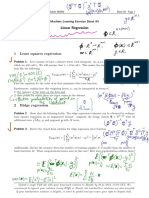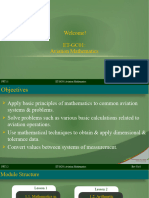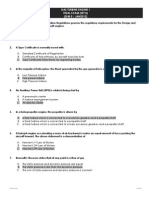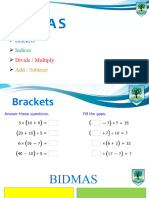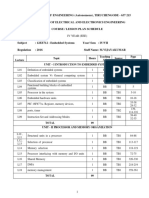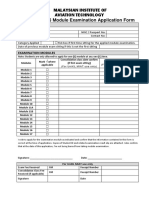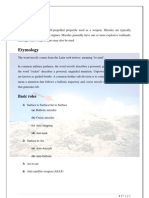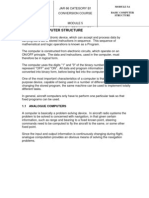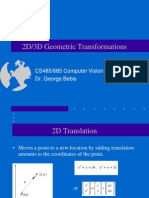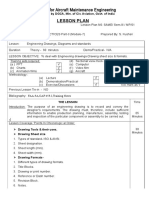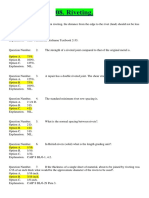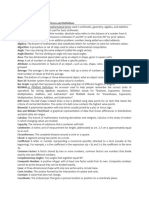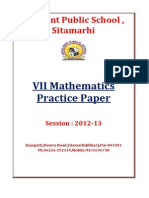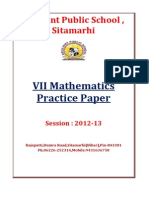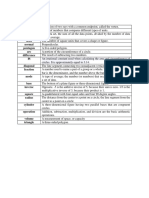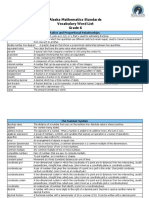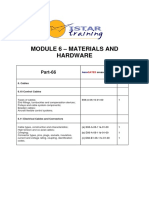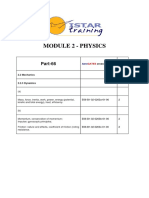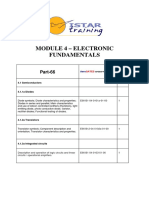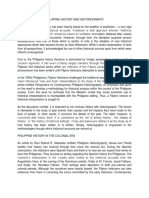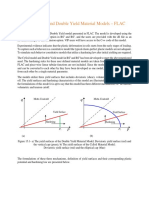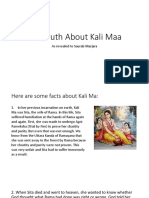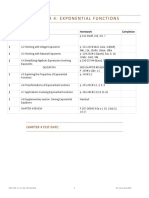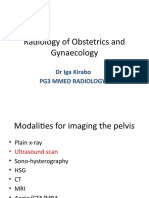Math Dictionary For EASA Module 1 Study
Math Dictionary For EASA Module 1 Study
Uploaded by
Steven J. SelcukCopyright:
Available Formats
Math Dictionary For EASA Module 1 Study
Math Dictionary For EASA Module 1 Study
Uploaded by
Steven J. SelcukOriginal Description:
Original Title
Copyright
Available Formats
Share this document
Did you find this document useful?
Is this content inappropriate?
Copyright:
Available Formats
Math Dictionary For EASA Module 1 Study
Math Dictionary For EASA Module 1 Study
Uploaded by
Steven J. SelcukCopyright:
Available Formats
Math Dictionary
#Addition . The process in which the value of one number is added to
the value of another.
#Algebra . The branch of mathematics that uses letters or symbols to
represent numbers in formulas and equations.
#Area . A measurement of the amount of surface inside a two-
dimensional object.
Aspect ratio. The relationship of the length (wingtip to wingtip), or
span, of an airfoil to its width, or chord.
Associative property. The sum or product of two or more terms is the
same regardless of the order in which they are added or multiplied.
#Base . In mathematics, used to refer to a particular mathematical
object that is used as a building block. A base-a system is one that
uses a as a new unit from which point counting starts again. (See
#decimal system.) In the mathematical expression an, read as “a to
the nth power,” a is the base.
#Binary number system. The binary number system is a number system
that has only two digits, 0 (zero) and 1. Binary numbers are made from
a series of zeros and ones. An example of an 8-bit binary number is
11010010. The prefix “bi” in the word binary is a Latin root for the
word “two.”
#Binomial . Aan algebraic expression of the sum or difference of two
terms.
#Circle . A round plane figure whose boundary (the circumference)
consists of points equidistant from a fixed point (the center).
#Circumference(of a circle). The linear measurement of the distance
around a circle. The circumference is calculated by multiplying the
diameter of the circle by 3.1416.
#Coefficient . In algebra, a number placed before and multiplying the
variable in an algebraic expression (i.e., the 2 in 2x).
Commutative property. The sum of term does not change regardless of
the order in which the terms are added.
#Cone . A solid or hollow object that tapers from a circular base to
a point.
#Constant . In algebra, a number that appears on its own (without
being combined with a variable).
#Cosine (cos). A trigonometric function comparing two sides of a
right triangle as follows:
#Cube . A symmetrical three-dimensional shape, either solid or
hollow, contained by six equal squares.
#Cylinder . A hollow or solid object with parallel sides the ends of
which are identical circles.
Decimal system. The number system, also called the base-ten system,
based on the number 10. Consisting of ten symbols, or digits (0, 1, 2,
3, 4, 5, 6, 7, 8, 9), the main principle is that 10 is considered as a
new unit from which point counting starts again.
#Denominator . The lower part of a fraction (represented by the letter
D in N⁄D), the quantity by which the numerator is divided.
#Diameter (circle). The length of a line passing directly through the
center of a circle. Twice the radius of the circle.
#Difference . The answer to a subtraction problem.
Distributive property of multiplication. When multiplication it is
performed on two or more quantities already combined by another
operation, the result is the same as when it is performed on each
quantity individually and the products then combined.
#Dividend . In a division problem, the number to be divided by the
divisor. In 6 ÷ 2 = 3, the dividend is 6.
#Division . The process of finding how many times one number (the
divisor) is contained in another number (the dividend).
#Divisor . In a division problem, the number by which dividend is to
be divided. In 6 ÷ 2 = 3, the divisor is 2.
#Ellipse . A regular oval shape, traced by a point moving in a plane
so that the sum of its distances from two other points (the foci) is
constant, or resulting when a cone is cut by an oblique plane that
does not intersect the base.
#Exponent ( #power ). A shorthand method of indicating how many
times a number, called the base, is multiplied by itself. For example,
in the number 43, the 3 is the power or exponent and 4 is the base.
That is, 43 is equal to 4 × 4 × 4 = 64.
#Expression . In algebra, a collection of symbols that jointly express
a quantity.
#Fraction . A number written in the form N ⁄ D in which N is the
numerator and D is the denominator. For example, 5⁄16 is a fraction.
#Function . A mathematic expression that defines the relationship
between an input and an output.
Graph. A diagram showing the relation between variable quantities,
typically of two variables, each measured along one of a pair of axes
at right angles.
#Hypotenuse . The side of a right triangle that is opposite the right
angle. The hypotenuse is the longest side of a right triangle.
Improper fraction. A fraction with the numerator equal to or greater
than the denominator.
#Index : (plural: indices). The power or exponent of a number.
#Logarithm . A quantity representing the power to which a fixed number
(the base) must be raised to produce a given number.
Linear equation. An equation between two variables that gives a
straight line when plotted on a graph.
Maintenance. This includes inspection, overhaul, repair, preservation,
and the replacement of parts, but excludes preventive maintenance.
Mixed number. A combination of a whole number and a fraction. For
example, 5 3⁄8 is a mixed number.
Monomial. An algebraic expression existing of one term. polynomial.
#Multiplication . The process of repeated addition.
Negative number. A number that is less than zero.
Nomogram. A graph that usually consists of three sets of data.
Knowledge of any two sets of data enables the reader to determine the
third set.
#Numerator . The upper part of a fraction (represented by the letter N
in N⁄D).
Ordered pair. A pair of variable such as (x, y) which describe the
location of a point on a graph. The first variable (x) describes the
distance from the y axis. The second variable describes the distance
from the x axis.
#Parallelogram . A four-sided plane rectilinear figure with opposite
sides parallel.
#PEMDAS . An acronym used to remember the order in which mathematic
operations should be performed.
#Percentage . Used to express a number as a fraction of 100. Using the
percentage sign, %, 90 percent is expressed as 90%.
Place value. The numerical value of a digit by virtue of its position
in a number.
Polar coordinates. A pair of coordinates locating the position of a
point in a plane, the first being the length of the straight line (r)
connecting the point to the origin, and the second the angle (0) made
by this line with a fixed line such as the x axis.
#Polynomial . An expression of more than two algebraic terms, esp. the
sum of several terms that contain different powers of the same
variable(s).
Positive number. A number that is greater than zero.
#Power ( #exponent ). A shorthand method of indicating how many
times a number, called the base, is multiplied by itself. For example,
in the number 43, 3 is the power, or exponent, and 4 is the base. That
is, 43 is equal to 4 × 4 × 4 = 64.
Powers of ten. Also called scientific notation. It is a shorthand
method of depicting very large or very small numbers.
#Proportion . A proportion is a statement of equality between two or
more ratios. The example of A is to B as C is to D can be represented
A:B = C:D or A/B = C/D.
#Pythagoras ' Theorem. An equation used to find the length of a third
side of any right triangle when the lengths of two sides are known.
The Pythagoras' Theorem states that a2 + b2 = c2. The square of the
hypotenuse (side opposite the right angle) is equal to the sum of the
squares of the other two sides (a and b).
#Quadratic equation. An equation in which the variable has a power of
two.
#Quotient . The result of dividing two numbers. Radical sign. The
symbol √, used to indicate the root of a number.
#Radius (circle). Equal to one-half the diameter of a circle.
#Ratio . The comparison of two numbers or quantities.
#Rectangle . A plane figure with four straight sides and four right
angles, esp. one with unequal adjacent sides, in contrast to a square.
Rectangular coordinates. A pair of coordinates measured along axes at
right angles to one another.
#Root . A number that when multiplied by itself a specified number of
times will produce a given number. The two most commonly used roots
are the square root and the cube root.
Scientific notation. Used as a type of shorthand to express very large
or very small numbers. For example, to express 1,250,000,000,000 in
scientific notation is 1.25 × 1012.
Signed numbers. A signed number can be either a positive or negative
number. A positive number is a number that is greater than zero. A
negative number is a number that is less than zero.
Simultaneous equation. Equations involving two or more variables that
have the same value in each equation.
#Sine . A trigonometric function comparing two sides of a right
triangle as follows:
Square root. A non-negative number that must be multiplied by itself
to equal a given number.
#Subtraction . The process where the value of one number is taken from
the value of another.
Slant angle. The direct distance from an aircraft to a input location
on the surface of the earth.
#Sphere . A round solid figure, or its surface, with every point on
its surface equidistant from its center.
#Square . A plane figure with four equal straight sides and four
right angles.
#Sum . The resulting answer in the addition process.
#Tangent (tan). A trigonometric function comparing two sides of a
right triangle as follows:
Term. In algebra, each of the quantities in a mathematic expression.
#Trapezoid . A four-sided figure with one pair of parallel sides.
#Triangle . A three-sided figure in which the sum of the three angles
equal 180°.
#Trigonometry . The study of the relationships between the angles and
sides of a triangle.
#Variable . In algebra, a quantity represented by a letter or symbol
that is assumed to be capable of varying.
#Volume . The amount of space within a three-dimensional solid.
Whole numbers. The numbers: 0, 1, 2, 3, 4, 5, and so on.
You might also like
- IBT Sample Paper Grade 4 EnglishDocument6 pagesIBT Sample Paper Grade 4 EnglishNestor D'souza54% (13)
- Asset Management PAS 55 ISO 55000Document15 pagesAsset Management PAS 55 ISO 55000Prathap Selvam100% (1)
- Exercise 04 Linear Regression PDFDocument17 pagesExercise 04 Linear Regression PDFAndreea MusatNo ratings yet
- Aer416, Flight Mechanics SolutionsDocument2 pagesAer416, Flight Mechanics SolutionsUrshia Likes CookiesNo ratings yet
- 3 Idiots Reflection PaperDocument2 pages3 Idiots Reflection Paperjeemer100% (2)
- CPCS 222 Discrete Structures I Boolean AlgebraDocument54 pagesCPCS 222 Discrete Structures I Boolean AlgebraAmong AssNo ratings yet
- ET-GC01 Mathematics PPT Final R0Document105 pagesET-GC01 Mathematics PPT Final R0Omar AdamNo ratings yet
- Turbine1 FinalDocument7 pagesTurbine1 Finalmohd shahir100% (2)
- Stability Augmentation SystemsDocument4 pagesStability Augmentation SystemsSuraj ChaurasiyaNo ratings yet
- 62d1-Indices and BIDMAS PresentationDocument10 pages62d1-Indices and BIDMAS Presentationskyeye59050No ratings yet
- Chapter III Propulsion Systems Thrust and Performance ParametersDocument29 pagesChapter III Propulsion Systems Thrust and Performance ParametersshmyeNo ratings yet
- EASA Part 66 Module 1 MathematicsDocument14 pagesEASA Part 66 Module 1 MathematicsHussainAhmed100% (1)
- Embedded SystemDocument28 pagesEmbedded Systemnanobala15No ratings yet
- DCAM Module Exam Application FormDocument10 pagesDCAM Module Exam Application FormArief SambestNo ratings yet
- Manual NsisDocument252 pagesManual NsisVasco Graça0% (1)
- GyroscopesDocument34 pagesGyroscopesNikhil SinghNo ratings yet
- Chapter7 Lecture 24-26performance Analysis III - Range and EnduranceDocument10 pagesChapter7 Lecture 24-26performance Analysis III - Range and EnduranceChegrani AhmedNo ratings yet
- Computational Aerodynamics: Name:Akhil Raj - Awale ROLL NO:17951A2105Document15 pagesComputational Aerodynamics: Name:Akhil Raj - Awale ROLL NO:17951A2105Jaikar Jaikar RahulNo ratings yet
- GRE Maths Syllabus (Quantitative Reasoning) : ArithmeticDocument2 pagesGRE Maths Syllabus (Quantitative Reasoning) : ArithmeticHarish RNo ratings yet
- MissileDocument14 pagesMissileTasmia Tamanna100% (1)
- Design ConstructionDocument157 pagesDesign ConstructionfarahNo ratings yet
- EAS 3312 Aeroelasticity: Assignment 2Document18 pagesEAS 3312 Aeroelasticity: Assignment 2Rijal DinNo ratings yet
- AE2406 Lab ManualDocument73 pagesAE2406 Lab ManualSathya NarayananNo ratings yet
- Isidoro Martinez - Aircraft Propulsion PDFDocument41 pagesIsidoro Martinez - Aircraft Propulsion PDFjoereisNo ratings yet
- GyroscopesDocument15 pagesGyroscopesgeenjunkmailNo ratings yet
- Fluid Network Analysis II: MEBS6008 Environmental Services IIDocument48 pagesFluid Network Analysis II: MEBS6008 Environmental Services IIahtin618100% (1)
- GATE AerospaceDocument3 pagesGATE AerospacevararajuNo ratings yet
- Physics Notes Grade 10 PDFDocument23 pagesPhysics Notes Grade 10 PDFRoyson HendersonNo ratings yet
- BM01 Das.b1&b2-2024Document130 pagesBM01 Das.b1&b2-2024dasNo ratings yet
- Seminar Report On Aerofoil NACA Designation in CFDDocument23 pagesSeminar Report On Aerofoil NACA Designation in CFDSandeep Ajayakumar100% (1)
- Easa Basic Computer StructureDocument33 pagesEasa Basic Computer StructureAlaa MortadaNo ratings yet
- Module Exam Application Form PDFDocument10 pagesModule Exam Application Form PDFBazli UmarNo ratings yet
- Open AeroDocument16 pagesOpen AerodasdllllNo ratings yet
- Aircraft PerformanceDocument2 pagesAircraft PerformanceAishwarya Ravi0% (1)
- Aerodynamic Modeling of A Membrane WingDocument236 pagesAerodynamic Modeling of A Membrane Wingmatthew_6No ratings yet
- Module 14 Propulsion Notes-3 PDFDocument5 pagesModule 14 Propulsion Notes-3 PDFastikNo ratings yet
- Elect Questions For Paper IIDocument49 pagesElect Questions For Paper IIavijayakumar_1964No ratings yet
- Question and Answer Flip FlopDocument4 pagesQuestion and Answer Flip FlopCharize Angeli Lumidao - MagdaelNo ratings yet
- Geometric TransformationsDocument40 pagesGeometric TransformationssfundsNo ratings yet
- Aircraft Performance-2 PDFDocument6 pagesAircraft Performance-2 PDFkkkrajaNo ratings yet
- AsDocument7 pagesAsGogo P0% (1)
- Lesson Plan: School For Aircraft Maintenance EngineeringDocument3 pagesLesson Plan: School For Aircraft Maintenance Engineeringarindam debnathNo ratings yet
- Dynamic Modeling of Fixed-Wing UAVs (12.05.2006)Document12 pagesDynamic Modeling of Fixed-Wing UAVs (12.05.2006)Максим АнтіповNo ratings yet
- Introduction To The Method of Characteristics and The Minimum Length NozzleDocument52 pagesIntroduction To The Method of Characteristics and The Minimum Length Nozzledurgesh3guptaNo ratings yet
- Lec27 Problem Solution PDFDocument22 pagesLec27 Problem Solution PDFmaya singhNo ratings yet
- EASA AERODYNAMIC Module TESTDocument7 pagesEASA AERODYNAMIC Module TESTxristophorosNo ratings yet
- AcronymsDocument143 pagesAcronymsyans77No ratings yet
- Main Practice 1Document7 pagesMain Practice 1sureshrnalNo ratings yet
- Rr312102 Aircraft PerformanceDocument8 pagesRr312102 Aircraft PerformanceSrinivasa Rao GNo ratings yet
- Material & HardwareDocument381 pagesMaterial & HardwareVS KRISHNA KUMARNo ratings yet
- ME-354 Quiz 3 SolutionsDocument6 pagesME-354 Quiz 3 Solutionsjf2oo6No ratings yet
- Airman Knowledge Test Qs With AnswersDocument48 pagesAirman Knowledge Test Qs With AnswersSharat Jha0% (1)
- Experimental Aerodyamics SyllabusDocument1 pageExperimental Aerodyamics Syllabustjpk100% (1)
- Review Questions: Multiple ChoiceDocument8 pagesReview Questions: Multiple ChoiceExan JohnNo ratings yet
- Question Bank AerodynamicDocument7 pagesQuestion Bank AerodynamicAjay DeshmukhNo ratings yet
- Math GlossaryDocument6 pagesMath GlossaryparunitraNo ratings yet
- Math TermsDocument19 pagesMath TermsCrichelle Mae Deliva Caceres100% (1)
- Math TermsDocument6 pagesMath TermsChristelle Kaye BisnarNo ratings yet
- VII Mathematics C.B.S.E. Practice PaperDocument117 pagesVII Mathematics C.B.S.E. Practice Paperspatel1972No ratings yet
- VII Mathematics C.B.S.E. Practice PaperDocument117 pagesVII Mathematics C.B.S.E. Practice Papersivsyadav100% (1)
- Spelling Bee MathsDocument3 pagesSpelling Bee MathsWeisheng Neo50% (2)
- Math Vocabulary Grade6Document12 pagesMath Vocabulary Grade6Mariana HillNo ratings yet
- Module 2 - Physics: Part-66Document1 pageModule 2 - Physics: Part-66Steven J. SelcukNo ratings yet
- EASA Module 2 Questions and ExplanationsDocument6 pagesEASA Module 2 Questions and ExplanationsSteven J. SelcukNo ratings yet
- Module 1 - Mathematics: Part-66Document1 pageModule 1 - Mathematics: Part-66Steven J. SelcukNo ratings yet
- Module 1 - Mathematics: Part-66Document1 pageModule 1 - Mathematics: Part-66Steven J. SelcukNo ratings yet
- Module 3 - Electrical Fundamentals: Part-66Document1 pageModule 3 - Electrical Fundamentals: Part-66Steven J. SelcukNo ratings yet
- Module 2 - Physics: Part-66Document1 pageModule 2 - Physics: Part-66Steven J. SelcukNo ratings yet
- E66 A 06 CablesDocument1 pageE66 A 06 CablesSteven J. SelcukNo ratings yet
- Module 2 - Physics: Part-66Document1 pageModule 2 - Physics: Part-66Steven J. Selcuk0% (1)
- Module 2 - Physics: Part-66Document1 pageModule 2 - Physics: Part-66Steven J. SelcukNo ratings yet
- Module 1 - Mathematics: Part-66Document1 pageModule 1 - Mathematics: Part-66Steven J. SelcukNo ratings yet
- E66 B1 04 SemiconductorsDocument1 pageE66 B1 04 SemiconductorsSteven J. SelcukNo ratings yet
- Module 1 - Mathematics: Part-66Document1 pageModule 1 - Mathematics: Part-66Steven J. SelcukNo ratings yet
- E66 B11 05 Digital DevicesDocument1 pageE66 B11 05 Digital DevicesSteven J. SelcukNo ratings yet
- Module 2 - Physics: Part-66Document1 pageModule 2 - Physics: Part-66Steven J. SelcukNo ratings yet
- Module 2 - Physics: Part-66Document1 pageModule 2 - Physics: Part-66Steven J. SelcukNo ratings yet
- Module 2 - Physics: Part-66Document1 pageModule 2 - Physics: Part-66Steven J. SelcukNo ratings yet
- E66 B2 04 ServosDocument1 pageE66 B2 04 ServosSteven J. SelcukNo ratings yet
- Module 4 - Electronic Fundamentals: Part-66Document1 pageModule 4 - Electronic Fundamentals: Part-66Steven J. SelcukNo ratings yet
- E66 A 06 Another DevicesDocument1 pageE66 A 06 Another DevicesSteven J. SelcukNo ratings yet
- Module 2 - Physics: Part-66Document1 pageModule 2 - Physics: Part-66Steven J. SelcukNo ratings yet
- Module 3 - Electrical Fundamentals: Part-66Document1 pageModule 3 - Electrical Fundamentals: Part-66Steven J. SelcukNo ratings yet
- E66 B2 04 01 DiodesDocument2 pagesE66 B2 04 01 DiodesSteven J. Selcuk0% (1)
- Approximate Analysis of Statically Indeterminate Structures - Back-Of-The Envelope CalculationsDocument23 pagesApproximate Analysis of Statically Indeterminate Structures - Back-Of-The Envelope CalculationsNita NabanitaNo ratings yet
- The Concept of Purity in Tess D'urbervilleDocument14 pagesThe Concept of Purity in Tess D'urbervilleBianca DarieNo ratings yet
- Philippine History and Historiography PDFDocument6 pagesPhilippine History and Historiography PDFglory ostulanoNo ratings yet
- Macroeconomics Test #1 (Ch. 5:6) Flashcards - QuizletDocument10 pagesMacroeconomics Test #1 (Ch. 5:6) Flashcards - QuizletElizabeth Alarcón-GaxiolaNo ratings yet
- PREFACEDocument20 pagesPREFACEguptaakash25999No ratings yet
- 15-Double Yield Model - FLACDocument6 pages15-Double Yield Model - FLACKTMONo ratings yet
- Fourteen Poems of Love and Death, Federico Garcia LorcaDocument33 pagesFourteen Poems of Love and Death, Federico Garcia LorcaAndrea RaicevicNo ratings yet
- SOCSCI 4 SyllabusDocument5 pagesSOCSCI 4 SyllabusGlenn Pasia0% (1)
- Truth About KaliDocument19 pagesTruth About KalisaurabNo ratings yet
- SHUNYA SAMPADANE_ The Main Scripture of the Veerashaivas. A concise composition.Document240 pagesSHUNYA SAMPADANE_ The Main Scripture of the Veerashaivas. A concise composition.regan.hartleyNo ratings yet
- FREYTAGDocument3 pagesFREYTAGChelsy Kate CastigonNo ratings yet
- Banee Israaeel 09Document6 pagesBanee Israaeel 09NL GamerNo ratings yet
- William Shakespeare 2Document22 pagesWilliam Shakespeare 2Laura GompaNo ratings yet
- MCR 3u5 Chapter 4Document20 pagesMCR 3u5 Chapter 4Veceslav VladanNo ratings yet
- Patterning Instinct ForewordDocument3 pagesPatterning Instinct ForewordPveruss100% (1)
- Maiya: Design by Serah Basnet - Tales of Twisted FibersDocument5 pagesMaiya: Design by Serah Basnet - Tales of Twisted FibersEmanuela Soares100% (1)
- Radiology of Obstetrics and GynaecologyDocument61 pagesRadiology of Obstetrics and GynaecologyMUBIRU SAMUEL EDWARDNo ratings yet
- Mix VarianceDocument1 pageMix VarianceClaire BarrettoNo ratings yet
- Diagnosis and Treatment of Limb Fractures Associated With Acute Peripheral IschemiaDocument6 pagesDiagnosis and Treatment of Limb Fractures Associated With Acute Peripheral IschemiaramadhaniandaNo ratings yet
- Personal Narrative Essay Thesis ExamplesDocument8 pagesPersonal Narrative Essay Thesis Examplesdqaucoikd100% (2)
- Writing A Descriptive Essay On A Person / Place / Festival / Event / ExperienceDocument17 pagesWriting A Descriptive Essay On A Person / Place / Festival / Event / ExperienceChaimae Sweet100% (1)
- 2 God and Biblical Interpretation: Notes For Chapter 1Document2 pages2 God and Biblical Interpretation: Notes For Chapter 1lagger11No ratings yet
- Acord Vs Zamora Case DigestDocument5 pagesAcord Vs Zamora Case DigestJohn SolivenNo ratings yet
- What Is Socrates Irony ?Document13 pagesWhat Is Socrates Irony ?AponNo ratings yet
- A Framework For Auditing HRDocument11 pagesA Framework For Auditing HRadedoyin123No ratings yet
- What S New in Mentum Planet 6.0 ExternalDocument63 pagesWhat S New in Mentum Planet 6.0 ExternalhazzanollyNo ratings yet
- CASE #1 Firestone v. CADocument2 pagesCASE #1 Firestone v. CApistekayawaNo ratings yet


